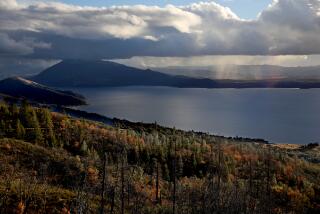THE OUTDOORS : FISH STORIES : Legends Have Muddied Waters at Clear Lake, But the Truth Is Crystal Clear: The Angling’s Great
CLEAR LAKE, Calif. — The truth about Clear Lake:
It isn’t.
Furthermore, said Terry Knight, a free-lance writer and fishing guide, “Although this lake is known across the country for its bass, catfish is by far the most popular form of fishing.”
And the crappie . . . To many anglers, the bass aren’t even second.
Around Clear Lake, it is sometimes difficult to separate legend from fact. There are tales of haunted houses built over ancient Pomo Indian burial grounds. Residents hear parties going on in the next room--until they go check.
Archeologists from UC Davis took some core samples from the bottom of the lake and determined that it might be the oldest lake in the world--more than 5 million years old.
“They know it’s one of the top 10,” said Ann Jernigan, director of sales for the Konocti Harbor Inn on the southwest side of the lake.
Some of the houses around the lake seem almost that old, their roofs warped and their docks collapsing into the water by degrees. Yet in other areas along the 110 miles of shoreline, there are million-dollar mansions. Clear Lake, clearly, is a place of contradictions.
What is known is that spring-fed Clear Lake is up to eight miles wide and 25 miles long, northwest of Sacramento and north of San Francisco. It’s the largest natural lake entirely within the state of California. The east side of Lake Tahoe is in Nevada.
But about that name. The locals are first to acknowledge that while the lake might appear bright blue from a distance most of the year, upon close inspection it is as clear as pea soup.
Algae. It’s green and it’s slimy, and in the heat of summer when it blooms and floats to the surface and rots, it offends the nose as much as the eyes.
“There are certain times of year I don’t want to bathe in it,” Jernigan said. “But I take my water out of the lake and it hasn’t hurt me yet.”
The Lake County Health Dept. checks the water quality regularly and has never issued a warning because of algae.
The fish will never complain. Their food chain starts with the algae, which feeds the zoo plankton, which feed the other aquatic life such as threadfin shad, silverside minnows and crawfish, which become fare for those monster catfish, big bass and the state record white crappie, among others.
“If we took the algae out, you could kiss off the crappie and the catfish and the bass and maybe catch a carp,” Knight said.
The mercury is another story.
In 1986 the State Department of Health Services found slightly more than one part per million in some Clear Lake fish, requiring it to issue a warning on consumption.
“An L.A. TV station said people were dying from swimming in the lake,” Knight said. “Dogs were dying from drinking water around the lake. It got all blown out of hand.
“Many of the lakes in northern California have mercury levels exceeding the state standards. Fish from Clear Lake can be safely eaten by just following the guidelines issued by the State Department of Health Services.”
A notice on Page 2 of the 1989 California Sport Fishing Regulations refers specifically to Clear Lake: “Because of the elevated mercury levels, women who are pregnant or may soon become pregnant, nursing mothers, and children under age 6 should not eat fish from Clear Lake, Lake County. Adults should eat no more than the amount indicated below . . . children 6-15 . . . no more than half the amount indicated.”
Basically, the guide goes on to say, the adult limit is 1 to 3 pounds per month, depending on the size and species, big fish being worst. That might be enough to encourage catch and release, because most of the fish caught in Clear Lake are oversize.
The lake records are 13.96 pounds for a Florida largemouth bass, caught by Bob Cagle of Yuba City in 1984; a 33-pound channel catfish in ’77 and a 4-pound, 8-ounce white crappie in the mid-’60s.
But about those bass. The lake will play host to between 17 and 20 professional bass tournaments each year, so there must be something to its reputation as the best all-round bass lake in the West.
That’s right, Knight said--but first he wanted to talk about the crappie. They were here before the bass.
“The resorts were built to support crappie fishing,” Knight said. “They’re the meat and potatoes fish of this lake, a tremendous success story.”
A story is told about someone seeing a kid with a black crappie estimated to be about 4 pounds. The kid was asked if he intended to get it officially weighed.
“No, I don’t have a fishing license,” he said. So he took it home and ate it.
The record for white crappie endures, but the species started disappearing from the lake in the early 1970s for unknown reasons. In 1984 the county’s Lakebed Management Department started replacing them with Florida black crappie fingerlings. Those now run to 2 to 3 pounds and, “as table fare, are impossible to beat,” Knight said.
Knight said catfish anglers outnumber bass anglers 3 to 1.
“A 15-pound catfish is common,” Knight said, adding that it takes a catfish weighing more than 25 pounds to win the annual catfish derby.
Some bow fishermen were having a carp derby a couple of years ago and one mistakenly put his arrow through a 17-pound bass. Several locals swear they have seen the fish mounted in the guy’s house.
Knight doesn’t claim that Clear Lake produces the biggest bass in the West, conceding that distinction to the San Diego lakes.
“But while our fish are not as large individually, the average is much higher,” he said. “You need to average 3 to 4 pounds a fish to win a tournament here. Even in Florida, most tournaments are won at about 2 pounds.
The techniques also are different than in other Western lakes. Being bowl-shaped and natural, rather than formed by a dam backing a river up into a gorge, Clear Lake is relatively shallow, averaging only 17 feet in depth and much less around the edges where most of the bass are caught.
Especially in the summer, when the water is as warm as 78 degrees, “those bass seek the shade of the docks,” Knight said. “Most are caught in two or three feet of water.”
But it takes a knack. Bass like underwater structures, and at Clear Lake most of the structures are on the shore, among the pilings and the tules.
Jerry Basgal, a lake resident who markets his homemade plastic lures, likes to fish those areas, as well as the deep reaches of the back-bay sloughs.
With a pair of fishing companions unfamiliar with the lake, he trolls his Ranger bass boat at super-slow speed along a muddy, overgrown bank where loose foliage floats on the surface and advises, “We’ll just throw it right in that junk there.”
Quickly, Basgal has a 3-pound, 14-ounce catch for his live well, due to be returned to the lake after a proper weigh-in.
Later, he casts among lily pads adjacent to a modern marina, demonstrating the “flipping” technique of short, low casts developed by experts at Clear Lake.
Another strike.
“If this was a tournament, I’d collect the money,” Basgal said.
It’s not and he won’t, but he’s happy because the fishing is usually good--and that’s the truth about Clear Lake.


